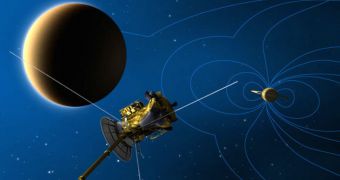The NASA/ESA Cassini spacecraft is currently getting ready to perform a new flyby of Saturn's moon Titan. This time, however, the venerable space probe, which has been orbiting the gas giant since 2004, will not primarily analyze the surface of the hydrocarbon lake-laden moon. Rather, it will focus on the magnetic interactions that appear between Saturn and Titan. Astronomers want to better understand how the two influence each other magnetically.
“The flyby will take place the evening of December 11 California time, or shortly after midnight Universal Time on December 12,” experts at the NASA Jet Propulsion Laboratory (JPL), who manage the mission, write on the lab's official website. The JPL is based at the California Institute of Technology (Caltech), in Pasadena. The group explains that Titan is definitely one of the most interesting celestial bodies in the solar system.
The moon has a radius about 0.4 that of Earth and a mass of 0.2 Earths, but its surface is covered in organic materials. Lakes of liquid hydrocarbons, such as methane and ethane, exist at both poles, and the chemical composition of its atmosphere reminds planetary scientists of our own planet's early days, when photosynthesis had not yet begun to change the gas balances. All these characteristics have made the Saturnine moon of interest to NASA and the scientific community. As proof, the new flight will be Cassini's sixty-fourth pass by the celestial body.
The last one was two months ago, but it focused on mapping the spread of the northern lakes, as experts tried to understand why there are differences in the distribution patterns of the lakes between the two poles. During the new flyby, Cassini will pass some 4,900 kilometers (3,000 miles) above the surface of Titan, the JPL team announces.
“As Titan plows through the magnetic bubble, or magnetosphere around Saturn, it creates a wake in the magnetic field lines coming away from the planet. This flyby will allow Cassini's fields and particles instruments to study that wake about 5,200 kilometers (3,200 miles) away from the moon, a relatively unexamined region. Other instruments will also be taking a closer look at Titan's clouds,” the JPL team says.

 14 DAY TRIAL //
14 DAY TRIAL //